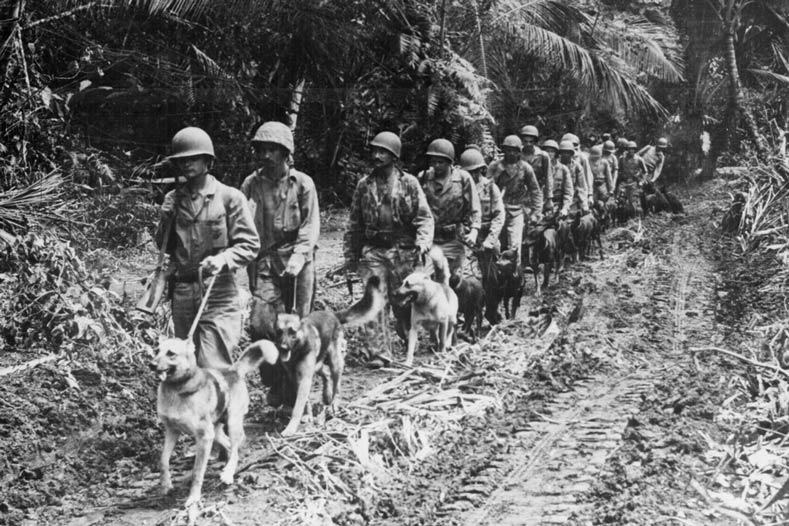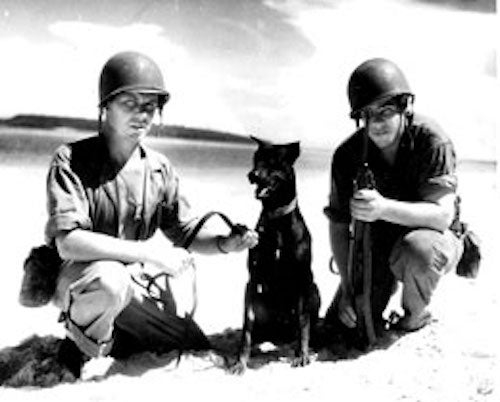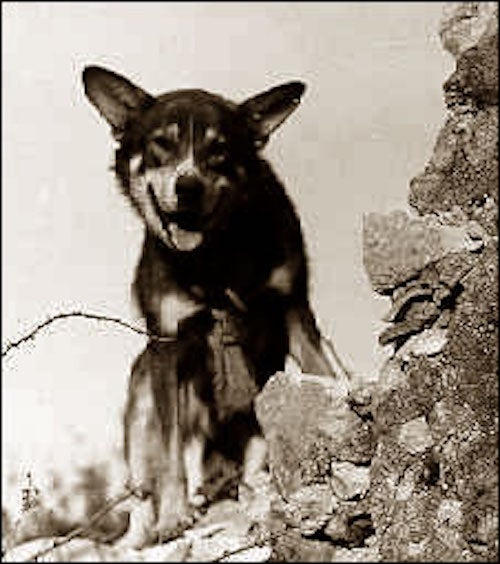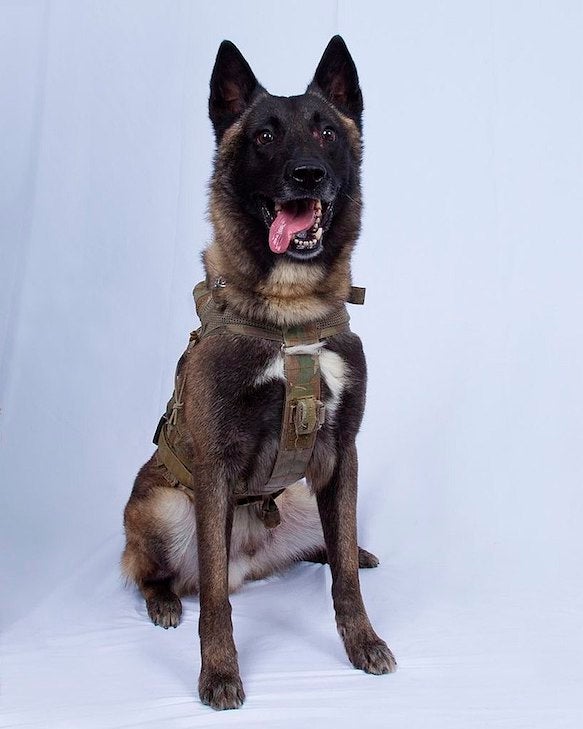
On Oct. 27, 2019, a 5-year-old Belgian Malinois military working dog named Conan took part in the Barisha raid, which resulted in the death of the leader of ISIS. Conan joined a long list of heroic military working dogs.
Call ‘em what you want — war dogs or military working dogs — they have been around for centuries worldwide. The states had an unofficial canine war force in World War I, but military dogs did not become officially recognized until March 13, 1942, when a private organization, Dogs for Defense was established to recruit the public’s dogs for the U.S. military’s War Dog Program, known as the K-9 Corps.
Another key supplier of war dogs was the Doberman Pinscher Club of America, which quickly became linked with the U.S. Marines. The Dobes became a face with the Marines and were given a rank, beginning as privates.

Prominent breeders and trainers were instrumental in appealing to the American public to donate its pet dogs in the war effort. The profile included specific breeds, either sex, between 1-5 years old, physically fit and with “watchdog traits.”
But some of those mandates were relaxed as it quickly became apparent there would not be enough dogs to meet the demand. Breeds and crosses were trimmed to about 30 breeds, led by Airedale Terriers, Boxers, Labrador Retrievers, German Shepherd Dogs, and Saint Bernards.
Donors were given a certificate by the government as a means of thanks for their “patriotic duty.” Dogs were immediately sent into training, where some excelled and others didn’t. Wash-outs were returned to their owners; those who passed were eventually sent into battle from foxholes to beach fronts, where they were utilized for messenger, mine-detection, sentry and scout duties.
Eventually, the military began training its own dogs, but by the war’s end, Dogs for Defense procured approximately 18,000 of the 20,000 dogs.
One of the WWII famed fur warriors was Chips, a German Shepherd/Alaskan Husky/Collie mix that was a donated New York family dog who is credited with saving the lives of many U.S. soldiers and earning a Purple Heart and Silver Star.

Korean War Dogs
Five years after WWII, the Korean Conflict triggered the need for military working dogs again. They were chiefly deployed on combat night patrols and were detested by the North Koreans and Chinese because of their ability to ambush snipers, penetrate enemy lines and scent out enemy positions. It reached a point where reports noted the foes were using loudspeakers saying, “Yankee, take your dog and go home!”
Despite the success of the canines on night patrols, the shuttling around of training duties on the home front resulted in only one Army scout-dog platoon seeing service in Korea. The Air Force, too, utilized dogs there, chiefly for patrolling air-base perimeters and guarding bomb dumps and supply areas.
Vietnam War Dogs
Fast forward to Vietnam – a totally new environment and job description for these “fur missiles,” as some military dog handlers described them. Welcome to thick vegetation, continued rain, subsequent mud and plenty of challenging heat and humidity.
In a terrific chronology, “Cold Nose, Brave Heart: Legendary American War Dogs,” by Linda McMaken in The Elks Magazine, May 2009, U.S. Marine LCPL Charles Yates of the 3rd Amphibian Tractor Battalion, 1st Marine Division, says, “Charlie hated our dogs. When the mortars hit, they went first for the ammo tent and second for the dog kennel. These dogs walked sentry and alerted us to many Viet Cong ambushes.” An estimated 4,000 dogs and 9,000 military-dog handlers served in Vietnam.
Their duties were widespread – scout, sentry, patrol, mine and booby-trap detection, water and combat. Like their predecessors in Korea, these four-legged soldiers were so hated by the Viet Cong, that they attracted a $20,000 bounty for their capture.

“Surplus Equipment”
When we exited Vietnam – in a hurry – the military working dogs that served our forces so admirably and saved untold lives were left behind, as they were classified as “surplus equipment.” Despite pleas from many handlers who were willing to pay their dog’s flight home, the military would not permit it. Consequently, some were transferred to the South Vietnamese military and police units who were not trained to handle them and others were euthanized. It is estimated that of 4,000 that served, fewer than 200 made it back to the U.S.
But that should never happen again. Following a public outcry, led by many irate former U.S. military-dog handlers, in 2000, Congress passed “Robby’s Law” allowing for the adoption of these dogs by law-enforcement agencies, former handlers and others capable of caring for them.
In a New York Times Opinion piece Oct. 3, 2017, Richard Cunningham, a sentry-dog handler in Vietnam and later a New York Police Department employee and fraud investigator concludes, “I’ve heard it said that without our military dogs, there would be 10,000 additional names on the Vietnam Veterans Memorial wall. I, for one, think that’s an understatement.”
Middle-Eastern War Dogs
In stark contrast to Vietnam, the hot, dusty environments of Iraq and Afghanistan serve up a new set of challenges for military working dogs trained for explosive and drug detection, sentry, therapy and service work.
In an Oct. 7, 2018 feature by Jon Michael Connor, Army Public Affairs on the U.S. Army website, William Cronin, director for the American K9 for Afghanistan and Mali, West Africa, says, “There’s no substitute for the detection of a dog. There’s no machine built yet that can reciprocate what a dog can do.

“When you go into your grandmother’s kitchen, you smell stew. The dog goes in your grandmother’s kitchen, he smells carrots, pepper, tomatoes, and lettuce. I mean he smells all the ingredients.”
Dogs’ sense of smell is roughly 50 times better than ours, meaning they can sniff out IEDs before they detonate and injure or kill U.S. servicemen in the prolonged Afghanistan and Iraq conflicts. Ground patrols are able to uncover only 50 percent of these, but with dogs, the detection rate increases to 80 percent, claims the Defense Department.

Military Dogs Today
Supply and demand for military working dogs is off the charts today.
According to retired Air Force K9 handler, Louis Robinson, a fully trained bomb detection canine is likely worth over $150,000, and considering the lives it may save, you could characterize it as priceless.
To augment the Defense Department’s breeding program at Lackland, the AKC was asked several years ago to assist and then implement a plan for a detection-dog breeding program within the U.S., since government agencies have for decades relied heavily on European stock to meet their growing needs.
Consequently, an AKC Detection Dog Task Force was established to raise the awareness and alert U.S. breeders, citizens and research organizations about the organization’s involvement. Well-attended conferences were held the past two years and another is planned in August in Durham, North Carolina, bringing experts together to determine how to better get U.S. breeders involved in producing sound dogs for explosive-detection and patrol-detection assignments.
A Perspectives report from the 2017 AKC Working Dog Conference notes “today over 80 percent of working/detector dogs in the U.S. are imported from Eastern Europe even though there an estimated 73 million dogs in the United States, of which about 10 million are purebred.
“. . . The primary difference between the domestic supply of dogs and those procured in Europe is that the European bred and trained working lines have a proven history of pedigrees from dogs selected for working traits. These traits are defined by the influence of competitive dog sports and the training requirements needed to participate at regional and national events.”
Federal and local government agencies and private vendors, according to a January 2019 AKC Detection Task Force Q&A draft, seek puppies 10-12 months of age. The Department of Defense conducts evaluations at its Lackland training center and requires the seller to bring the dog there, where it will be left for up to 10 days for assessment.
The task force is working in four ways to help fill the federal government’s need for quality canines.
Scott Thomas, task force consultant, cites those directions:
- It hosts the aforementioned conferences to create a neutral environment for the vendor, breeders and those purchasing dogs (private companies and federal government) to network and discuss issues.
- The AKC is actively meeting with government agencies to discuss the needs and the long-term solutions both in Washington, D.C. and at Lackland Air Force Base.
- The AKC has established a Patriotic Puppy Program to assist breeders in understanding how to raise detection dogs for sale to the government and private vendors. This system supports breeders and trainers with a website packed with current information, social-media updates and will soon be one of the largest databases for researching the genotype and phenotype of effective detection dogs.
- The task force has a government relations element that has proven highly successful in establishing legislation to ease the pathway for domestic breeders to supply dogs to local, state and federal agencies in need of dogs.
Thomas added, “Domestic breeders are very excited. For our pilot, we initially sought out the two breeds most often in demand for single-purpose detection work – the Labrador Retriever and the German Shorthair Pointer.
“We had significant interest from breeders outside those two and just completed receiving applications from those. It looks like the initial pilot effort will have just over 100 dogs, a number we hope to expand significantly in the near future. I can see this effort being coordinated into a national breeding effort to meet our national security need.”
View more historical photos of war dogs here.

